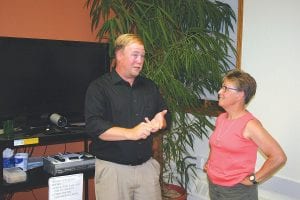Kurt Anderson discussed the effects sulfates have on wild rice with Barb Heideman after Anderson’s lecture which was held at the Community Education building on August 12. A scientist and gatherer of wild rice, Anderson presented his views to about 25 people who had many questions for him, some he could answer, and some that need more research before they can be answered.

From a scientific view point, Kurt Anderson believes the Minnesota Pollution Control Agency (MPCA) should take another look at the state’s current wild rice standard of 10 mg/ liter sulfate limit and revise it upward.
It’s not a popular position, one strongly contested by Minnesota Tribal Nations and conservation organizations, but as a scientist he said he believes there is reason that a higher sulfate level in the water won’t have a negative impact on growing wild rice.
Anderson gave his presentation to about 25 people on August 12 as part of the Cook County Higher Education Guest Lecture series.
As manager of environmental & land management of Minnesota Power and a long time gatherer of wild rice, Anderson said he cares a lot about the effects pollutants have on nature, but as a scientist who spent years performing toxicity studies on wild rice for the MPCA, Anderson said the state’s low sulfate standard needs to be looked at in a non-prejudiced way.
Much of the research the state uses came from the 1930s and 1940s, he said, which suggests higher sulfate levels can hurt the development of plants. Newer techniques and ways of looking at results suggest those studies may be outdated, said Anderson.
Anderson said sulfate is commonly found in air and water. At elevated levels, sulfate can cause harm to wild rice, which is more sensitive than humans to its presence.
In 2011 the Minnesota legislature granted $1.5 million from the Clean Water, Land and Legacy Amendment for a wild rice standards study.
With that funding, five studies were conducted by researchers at the University of Minnesota-Duluth and the University of Minnesota campus, and based on the results a Wild Rice Standards Study report was issued by Shannon Lotthammer, an environmental analyst for the MPCA.
Researchers used field studies, laboratory experiments and container experiments to reach their results, said Anderson, testing over 100 sites in the process, and each study took different approaches to examine how sulfate might affect wild rice.
In looking at those studies Anderson suggested that they point to sulfate levels that aren’t toxic to wild rice except at very high concentrations (e.g. 1,600 mg/L to 2,500 mg/L) and that healthy wild rice grows in waters with much higher concentrations than 10mg/L, with wild rice found in water with sulfates as high as 1,000 mg/L.
The Minnesota Chamber of Commerce argues that the research shows that the state’s sulfate standard should be 1,600 mg/L or higher, and it is a conclusion shared by the states iron and copper mining industry.
One thing Anderson didn’t argue was that when sulfate and iron mix, sulfide is created and when sulfide seeps into sediment it kills wild rice.
If the MPCA does enforce the current sulfate standard, which was adopted in 1973 and calls for no more than 10 mg/liter of sulfate, the only technology that will allow municipalities to treat water to that high standard is a membrane treatment (reverse osmosis), which will cost municipalities, and mines huge water bill increases. Those could get pushed onto local households who might see increases as high as $130 per month, Anderson said.
Anderson said he was pleased so far with the efforts of a panel of seven scientists who are taking a critical look at the State of Minnesota’s research into how sulfate may damage wild rice. The scientists, who hail from the U.S., Canada and Europe, are performing a peer review of the state’s $1.5 million study at the request of the MPCA.
The state also established an advisory committee to provide input on study protocol, research results and rulemaking and had the MPCA initiate rulemaking upon completing the study.
The legislative goal of the Wild Rice Standards was to “enhance understanding of the effects of sulfate on wild rice; inform standards evaluation.”
In early August 2014 a peer review meeting was held. A final meeting will be held and a summary will soon be forthcoming, said Anderson, who added that science didn’t have all of the answers yet, and more questions needed to be answered before changes to the state’s sulfate standard could be made, but if the standard changes, he hopes it’s based on scientific reasoning.
The MPCA Wild Rice Standards Study components were:
. Field survey of wild rice habitats to investigate physical and chemical conditions correlated with the presence or absence of wild rice stands.
. Controlled laboratory hydroponic experiments to determine the effect of elevated sulfate and sulfide on early stages of wild rice growth and development.
. Outdoor container experiments using natural sediments to determine the response of wild rice to a range of sulfate concentrations in the surface water, and associated sulfide in the rooting zone.
. Collection and analysis of rooting zone depth profiles of dissolved chemicals at wild rice outdoor container experiments and field sites to characterize sulfate, sulfide and iron in the rooting zone.
. Sediment incubation laboratory experiments to explore the difference temperature has on the rate that elevated sulfate in water enters underlying sediment, converts to sulfide, and to what degree sulfate is later released back into the water.


Loading Comments